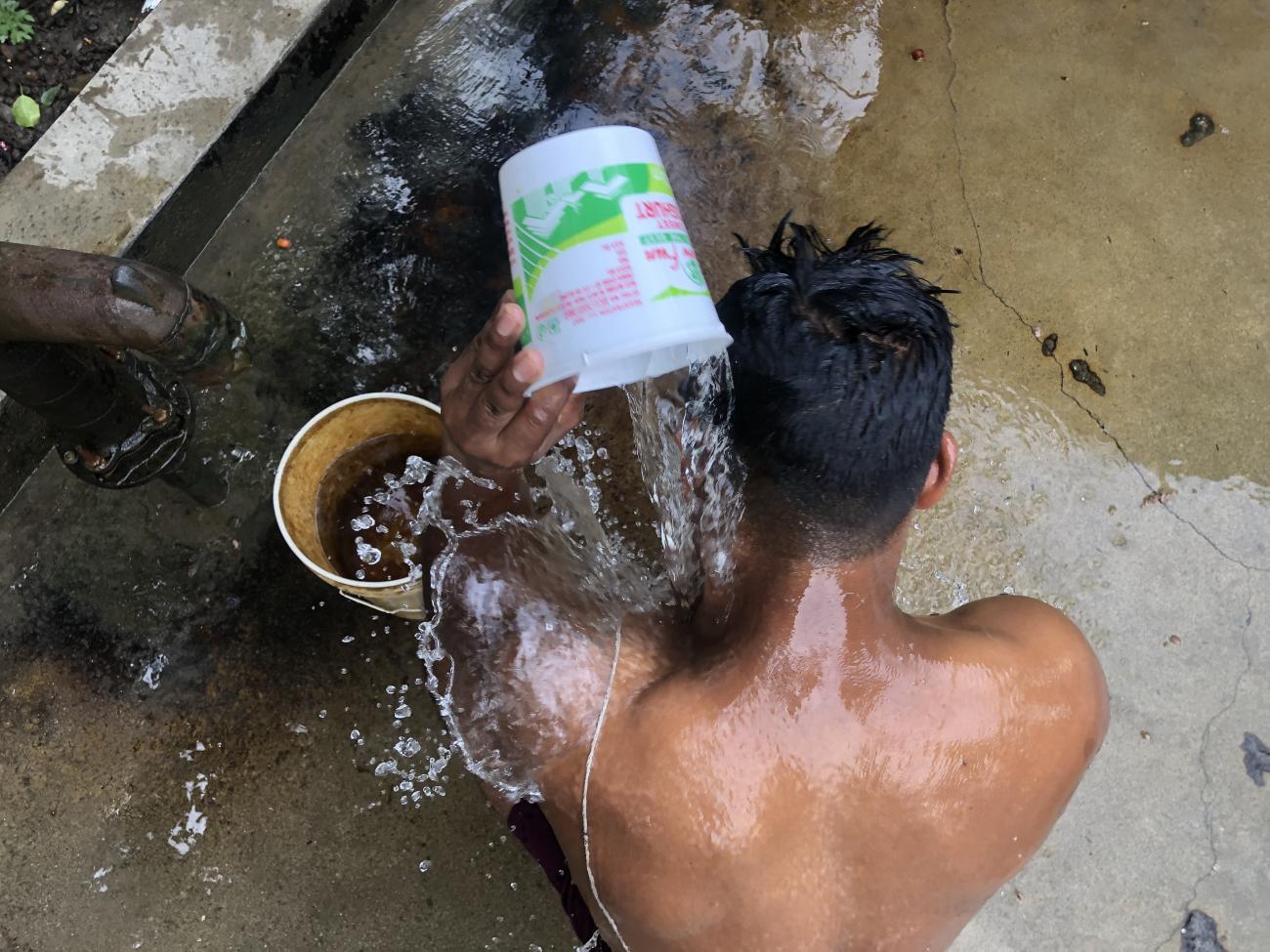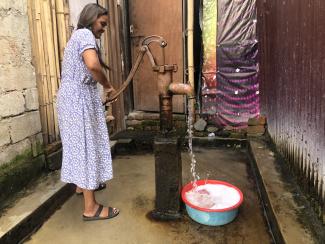On a cloudy day in late August, Saltu Mukhiya rushed to the toilet in his small makeshift bamboo home near the Bagmati River in the Thapathali district of Kathmandu, Nepal, as his brother-in-law Indresh Sahani recounted the last four months of turmoil from severe diarrhea.
"We haven't taken him to the hospital because we can't afford it," Sahani said. "He did take some medicine from a nearby pharmacy, but it's not working." With his daughter's help, Mukhiya, who is visually impaired, sat on the floor.
In the last 10 years, urbanization in cities such as Kathmandu has been growing rapidly but is largely unmanaged: no proper sewage system, no dedicated housing area, and construction without a proper urban development plan. As a result, rivers have become sewage dumping sites for companies, households, and hospitals alike, directly affecting the health and livelihood of the urban poor, such as Mukhiya, who live in slum areas near these rivers.
According to a recent report by the National Land Commission, at least 150,000 people in Nepal do not own their land and live as squatters; a quarter of them reside in informal settlements in the Kathmandu Valley. In urban settings, public health concerns are growing because of water pollution and climate change–induced events such as flash floods. The crisis is particularly pressing for marginalized families who do not have access to health care due to cost. "There's no one who thinks about us," said Mukhiya.
Public health policies have not adequately addressed the needs of the urban poor living in vulnerable slum areas
A study published in Nature in 2021 highlights significant concerns about water pollution and its link to waterborne diseases such as typhoid, cholera, paratyphoid fever, dysentery, jaundice, and amoebiasis. The report also warns of indirect exposure through shallow wells and vegetables grown with polluted water because river pollution is a major contributor of groundwater contamination in urban settings.
All seven tributaries of the Bagmati River—the Bagmati, Bishnumati, Manohara, Dhobikhola, Nakkhu, Balkhu, and Tukucha—in the Kathmandu Valley are polluted.
Growing Urban Poor, Growing Public Health Concern
According to the Living Standards Survey 2022–23, urban poverty in Nepal rose to 18.3% in 2023 from 15.5% in 2010–11 as rural poverty decreased from 27.4% to 24.7%. Despite this demographic shift, public health policies have not adequately addressed the needs of the urban poor living in vulnerable slum areas. Experts and advocates widely recognize urbanization in Nepal as being poorly managed by local and national government. Even Nepal's Urban Development Strategy 2017, which aims to "build vibrant urban settings," fails to adequately address the needs of the urban poor.
Dibesh Karmacharya, a public health researcher and founder of the Center for Molecular Dynamics Nepal, pointed out that "temporary or socioeconomically disadvantaged settlements often near rivers—not only in Kathmandu but also in other cities across the country—face major issues regarding access to safe drinking water and sanitation, making these areas more prone to waterborne and vector-borne diseases." Referencing this year's cholera infections and last year's dengue outbreak Karmacharya warned, "If we don't pay close attention to the growing threats, these settlements could become hotspots for communicable disease outbreaks, which could spill over to larger areas."
Official data from the Nepal Department of Health Services for 2022–23 confirms 56,000 confirmed cases of dengue, more than 35,000 of them in the hotspot of Bagmati Province–Kathmandu. That year, 88 people—most of whom were economically marginalized—died from mosquito-borne dengue. Cholera infections are also ongoing: 95 cases were confirmed as of the third week of September, 66 of them in Kathmandu. Cases of both dengue and cholera have increased every year; researchers cite climate change and urbanization as major driving factors.

Lived Fear and Struggle
Sirjana Magar, 37, became sick with cholera and fears that it may catch up with her again. "A few years back, I got infected with cholera and ended up in the hospital for days," she said while washing her dishes using water from a shallow water pump hardly 100 meters from the Bagmati River. "This [water] smells really bad, but there is no option, and I fear that I will get cholera this time also." For people like Magar, getting infected is a physical and economic burden. "There are big hospitals within a few minutes of [walking], but I fear even thinking about going there because it is not within our affordability. The only option is to go to an overcrowded government hospital or buy medicine from a local pharmacy without a doctor's prescription, which may not work."
Near Magar's house, 52-year-old Sita Ghatni was taking water from a water pump, and the water had a layer of foam, as if it were mixed with detergent. "It is what we get from this shallow tube well, and I think it is because of the polluted river," she said while trying to remove foam from her bucket. "We are forced to use this water for everything from cooking to bathing." She says most people are having skin-related issues, including allergies and fungal infections.
Those who live around these rivers are more vulnerable
Basant Gir, researcher
According to senior consultant dermatologist and venereologist Bhaskar Mohan Kayastha, polluted water can also cause fungal infections that can result in white marks on the body and in skin allergies. "Rivers in Kathmandu and other cities are mostly polluted, and it is common for people using that water to face skin-related issues along with other waterborne diseases."
Niraj Thapa, 32, showed white marks on his body and said, "In recent years, the water is getting more stinky, and because of that, I'm getting these marks and skin allergies too." Thapa, who works as a pickup truck driver, was taking a bath at a public well. "All members of my family are facing the same kind of problem, but I worry most about my three children. They get sick from fevers and runny noses pretty frequently, and they are also dealing with skin-related issues."
The Urban Poor Need Attention
The only permanent solution is using safe water. That, however, is not possible for socioeconomically marginalized urban poor.
In the Kathmandu Valley, 93% of wastewater comes from domestic sources and 7% is industrial wastewater. More than 95% of wastewater is estimated to be released without treatment into water bodies such as the Bagmati and Bishnumati Rivers.
According to the Ministry of Health and Population, currently no specific program targets urban poor and the health-related vulnerabilities they are experiencing. However, Nepal's supreme court recently ruled to limit construction along the Kathmandu River in an effort to address pollution.
Researcher Basant Giri, who leads the Kathmandu Institute of Applied Sciences, says that pollution in urban rivers and its impact is a harsh and overlooked reality. "Those who live around these rivers are more vulnerable. We are trying to find an accessible method to examine water quality," he said, relating his personal story, how he still boils water even when it is considered safe to drink. "For financially disadvantaged people, that might not be possible, but managing safe water is the only solution."
Experts argue that health care can be made more accessible to communities, emphasizing that health care needs to reach marginalized populations if they cannot come to or do not have access to it. From COVID-19 to Nepal's recent dengue outbreak, a lack of organization makes the spread of disease difficult to track. Advocates say targeted health investment and expansion of services not only serves the urban poor, but also can protect the entire city from a wider outbreak.
Karmacharya said, "Increasing investment in health care from the government and donor agencies is one solution, and another would be prioritizing communities in need, especially the urban poor."



